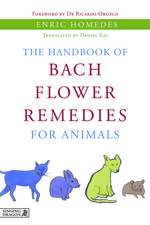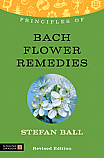$0.00 (0 items)
The Handbook of Bach Flower Remedies for Animals

The Handbook of Bach Flower Remedies for Animals
| SKU | SD170 | |
| Brand | Singing Dragon | |
| Unit Size | 234mm x 156mm / 9.25in x 6in, 256pp | |
| Properties | 2011, paperback, ISBN: 978-1-84819-075-7 | |
| English name | The Handbook of Bach Flower Remedies for Animals | |
| Description | The Handbook of Bach Flower Remedies for Animals
Enric Homedes Foreword by Dr. Ricardo Orozco Translated by Daniel Kai Bach Flower Remedies are dilutions of flower material developed by Edward Bach, an English physician and homeopath, in the 1930s. This practical handbook explains how Bach Flower Remedies can be highly effective for treating both behavioural and physical complaints in animals. Based on strong scientific research and detailed case studies, this book is a comprehensive resource that helps find solutions to common animal health and behaviour issues. The book lists each of the 38 flower remedies, explaining their properties and applications for both animals and humans. It then looks at specific animal ailments including conjunctivitis, allergies and phobias, and demonstrates how these problems can be successfully addressed using flower remedies. Practical advice about how to prepare and administer the remedies is included, as well as guidelines for using flower remedies in animal shelters. This book will be a valuable addition to the bookshelves of all pet owners, animal shelter workers, vets, ethologists and anyone with an interest in complementary and alternative medicines. Contents Foreword by Dr Ricardo Orozco. Acknowledgements. Introduction. Who was Dr Edward Bach? 1. How to Prepare Flower Remedies for an Animal. Preparation of a remedy for oral application. Preparation of a remedy for local application. 2. Administering the Flower Remedies to Animals. Direct application. Indirect application. Concentrate formula. 3. Rescue Remedy. 4. Study of Each of the 38 Bach Flowers. 4.1. Agrimony (Agrimonia eupatoria). 4.2. Aspen (Populus tremula). 4.3. Beech (Fagus sylvatica). 4.4. Centaury (Centarium umbellatum). 4.5. Cerato (Ceratostisgma willmottiana) 4.6. Cherry Plum (Prunus cerasifera). 4.7. Chestnut Bud (Aesculus hippocastanum). 4.8. Chicory (Cichorium intybus). 4.9. Clematis (Clematis vitalba). 4.10. Crab Apple (Malus pumila). 4.11. Elm (Ulmus procera). 4.12. Gentian (Gentianella amarella). 4.13. Gorse (Ulex europaeus). 4.14. Heather (Calluna vulgaris). 4.15. Holly (Llex aquifolium). 4.16. Honeysuckle (Lonicera caprifolium). 4.17. Hornbeam (Carpinus betulus). 4.18. Impatiens (Impatiens glandulifera). 4.19. Larch (Larix deciduas). 4.20. Mimulus (Mimulus guttatus). 4.21. Mustard (Sinapis arvensis). 4.22. Oak (Quercus robur). 4.23. Olive (Olea europaea). 4.24. Pine (Pinus sylvestris). 4.25. Red Chestnut (Aesculus carnea). 4.26. Rock Rose (Helianthemum nummularium). 4.27. Rock Water. 4.28. Scleranthus (Scleranthus annus). 4.29. Star of Bethlehem (Ornithogalum umbellatum). 4.30. Sweet Chestnut (Castanea sativa). 4.31. Vervain (Verbena officinalis). 4.32. Vine (Vitis vinfera). 4.33. Walnut (Juglans regia). 4.34. Water Violet (Hottonia palustris). 4.35. White Chestnut (Aesculus hippocastanum). 4.36. Wild Oat (Bromus ramosus). 4.37. Wild Rose (Rosa canina). 4.38. Willow (Salix vitellina). 5. Most Frequent Behavioural Problems. 5.1. Aggressiveness. 5.2. Separation Anxiety. 5.3. Jealousy: A baby's arrival. 5.4. Coprophagia. 5.5. Depression/Sadness. 5.6. Defecation and Urination in Inappropriate Places. 5.7. Stereotypic Behaviour. 5.8. Stress. 5.9. Canine Hyperactivity Disorder. 5.10. Canine and Feline Filial Imprint. 5.11. Fear and Panic (phobia). 5.12. Pseudocyesis (psychological pregnancy). 5.13. Socialization. 6. A Selection of Cases Treated. 6.1. For Aggressiveness. 6.2. For Anxiety. 6.3. For Jealousy. 6.4. Feline Idiopathic Cystitis. 6.5. Cophrophagia. 6.6. Defecation and Urination in Inappropriate Places. 6.7. Kidney Failure. 6.8. Leishmaniasis. 6.9. Feline Chronic Megacolon and Megaesophagus. 6.10. For Fear and Panic. 6.11. Pseudocyesis (psychological pregnancy). 6.12. Feline Urological Syndrome (FUS). 6.13. Repetitive Cough and Early Stage Anemia. 7. A Selection of Cases Treated by Local Applications. 7.1. Allergies. 7.2. Pus Lumps. 7.3. Conjunctivitis. 7.4. Infection and Abscess of the Anal Glands. 7.5. Inflammation and Infection of the Third Eyelid. 7.6. Leishmaniasis. 7.7. Sores and Burns as a Result of Poisoning. 7.8. Mastitis. 7.9. Cutaneous Nodule of Unknown Etiology. 7.10. Traumatism. 8. Work Methodology for Animal Shelters: Formulas and Guidelines. Treatments addressed to recently arrived animals. Treatments for animals leaving the shelter for adoption or foster care. Local treatments. Specific guidelines for animal shelters. 9. Useful Formulas. Abscesses. Colds. Conjunctivitis. Females in heat. Firework celebrations. Infection and abscess of the anal glands. Inflammation and infection of the third eyelid. Learning process. Mastitis. Otitis. Skin allergy. Traumatisms. Travel sickness (car journeys). Visits to the veterinarian preoperatory and postoperatory. Wounds. 10. Sterilization. Questions and Answers (by the Altarriba Foundation) What is sterilization? What is neutering? What is recommended? Why do you want to prevent the animal from enjoying its sexual life? Will you be sad at having your animal neutered? Will my pet put on weight? Will it change its character? Is it good for a female to breed at least once? Do veterinarians suggest sterilization in order to make money? What are the health benefits? Is it expensive? Will sterilizing your pet economically benefit pet shops and breeders? Are we entitled to deprive animals of what nature has given them? My animal is purebred. Will it be less of a guard dog? I really want to be present at a birth. I want to have an offspring from my pet. I will be responsible for the offspring. No one makes money if I have a litter. 11. References. 12. Further Reading. Index. Reviews 'I would recommend this book to any naturopath who would like to understand the mental states of patients, and to anyone who has a pet animal. With good instruction from an animal behavioural specialist, to correct the human element of the problem, and a knowledge of the Bach Flower remedies for the animal, a healthy, happy, loved, well behaved pet is virtually guaranteed.' - British Naturopathic Journal 'The handbook of Bach Flower Remedies' by professional therapist Enric Homedes is a gem which would be a great addition to any animal lovers' collection of complementary treatment 'bibles'... Enric's love of animals is clear in this beautiful book and in the invaluable guidance for those of us who have rescue animals with a variety of behavioural issues as a result of the stress of being taken into rescue care and then rehomed. He has a deep understanding of psychological and training issues involving dogs, and this is clear in the additional chapters that are included on neutering guidance and the use of the flower remedies specifically in rescue kennels. Overall, the word 'Handbook' is well chosen for this title, as it is an all-encompassing text for choosing and using the Bach Flower Remedy system to bring greater health and wellbeing to our beloved pets. The emphasis is on explaining and illustrating in a straight forward manner the technical aspects to using the remedies, so it is accessible to all who have an interest in the welfare of animals. I use the remedies regularly on animals, and will continue to do so as I become more and more convinced of the good that they bring to the lives of our pets. A book such as this builds confidence in choosing the right remedies and handling and administering them in the most effective way.' - Pet Lovers Digest 'The behavioral descriptions are particularly helpful, since they may provide insight into an animal's everyday patterns that an owner might otherwise miss. Also useful, the case study section helps to put these maladies into context, and show that sometimes it takes some tweaking of the flower remedies to get just the right mix. Because of its breadth of information, Homedes' work will be quite useful for anyone who identifies issues that might be treated with a flower remedy first rather than another trip to the vet... This well-written, very lucid guide to common pet behavioral problems and their treatment deserves to be a go-to reference for any animal owner.' - Foreword Reviews 'The professional experience of Homedes, partly described in this book, reminds us once again that Bach Flower Therapy is not a matter of faith, but of technical knowledge, of good practice and of method. I hope this work is distributed as widely as it deserves and helps those wonderful beings that offer us everything in exchange for almost nothing: animals.' - From the foreword by Dr. Ricardo Orozco, Bach Flower Therapist, and cofounder and president of SEDIBAC, Spain Author information Enric Homedes has been a professional Bach Flower Therapist since 1999 when he trained at the Edward Bach Institute. His professional activity involves therapy and tuition on the application of Bach Flower Remedies to humans and animals, and he is also a canine trainer. He is vice-president of SEDIBAC (The Society for the Study and Promotion of Bach Flower Remedies in Catalonia) and has organized and spoken at numerous congresses and conferences on Bach Flower Remedies. |
|
| Ingredients | The Handbook of Bach Flower Remedies for Animals | |


